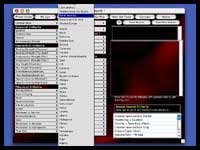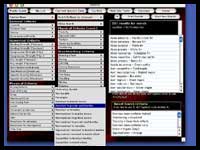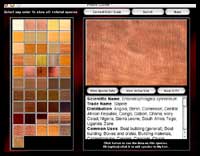

 The Wood Explorer
CD-ROM
The Wood Explorer
CD-ROM
Version 1.0
Review by Jim Mattson
From: Timber Solutions,
Inc
570 Lexington Ave
New York, NY 10022
US
Phone: (212)751-4940
www.thewoodexplorer.com
Email: support@thewoodexplorer.com
Price: $49.95
The information age is upon us and with it comes all types of new resources for woodworkers. What information we can't find in the print media we look for on the web. And when we need it even faster, you can't beat resources already installed on our computers. It's the wave of the future; the future is now.
Many of you will recall the Woods of the World CD-ROM for $50. It has elaborate information on over 800 species of wood from all over the world. I bought a copy back in 1996 and for some reason I let it slip out of memory. I tried to find my CD for this review but couldn't - I'm still looking.
In it's wake comes The Wood Explorer. The promise is a big one - put the information on over 1650 wood species on one CD. You can find the whole spiel here. Did the publishers deliver? Let's find out.
Installation
I installed The Wood Explorer on two different computers:
a Micron PC running at 633 MHz on Windows 98SE and an Apple Powerbook
running Mac OS X at 400 MHz. They give you three options for
installation: a full install of 100MB which puts all the program
files on your hard disk for faster response, a partial install
of 10MB which requires you run the program with the CD in the
drive tray, or no installation which runs The Wood Explorer
off the CD. I picked the first option for the Mac and the second
option for the PC; it was running low on hard drive space.
Both installations proceeded as expected given the normal particulars for each operating system. Even though the Windows installation was only minimal, response was very fast on both computers. One quirk: you need to have the CD in the drive to start the program no matter which installation you choose. I guess this is a hinderance to software pirating. Sigh...
 Searching
Searching
The mode of operation is simple - you have a question, you launch
the program to find an answer. The first step in that process
is clicking on the Search button, which pops open the
search window, at left.
Click on the image for a close-up view.
If you know which wood you're looking for, click on the Common Name button which pops open a text box for inputting the name. Let's say you want to find out all there is to know about Black Cherry. This is where you type in the words and hit enter to start the search. All the results arrive in the right-hand pane where you simply double-click the result you think most answers your search. Double-clicking the result sends you back to the main window where the "Black Cherry" data is displayed. We'll get into that later.
Included on the Search page are dozens of menus containing a variety of specific search catagories. You just pick a catagory, select the parameter which opens up in the menu and the results display in the screen at right. The results include all the woods which match your search criteria. To illustrate this concept, let's go through a sample search. In the above photo, I clicked on the Location button and selected North America as the first parameter.
 In the photo at left, I get 201 results,
or in other words, 201 different woods which are common to North
America. Double-clicking any wood brings up the info for that
particular North American species, but we have something else
in mind.
In the photo at left, I get 201 results,
or in other words, 201 different woods which are common to North
America. Double-clicking any wood brings up the info for that
particular North American species, but we have something else
in mind.
Click on the image for a close-up view.
To it's credit, The Wood Explorer let's you build on top of previous searches by selecting more catagories and parameters. Let's say you're a woodworker and you want to try drying your own green lumber. You know from friends that powder post beetles are a problem for some people air-drying wood and you want to find which native species have natural resistance (don't taste good) to the beetles. In the left-hand photo, I selected the Natural Durability catagory, clicking on "Resistant to powder post beetles", which reduces/refines the previous search to only 104 species of wood. Very cool!
Another great thing - the program saves each search in the lower-right window pane. By scrolling through this list, it's easy to see which searches you've performed in the past and double-clicking on a list item re-performs the search.
All is not well, however. If you clicked on the last image to see the close-up, you'll find other parameters for Natural Durability which might not be so familiar to woodworkers. There are two references to "furniture beetles". Are they the same as powder post beetles? If they are, why are they listed separately?
To understand this further, you need to know how the information was gathered. They've collected the data from dozens of references on wood. Instead of editing out (qualifying) certain information, they've quantified the occurances of each reference, placing those references which occur more frequently at the tops of your search results. What this means is two-fold, but let's expand on these aspects later.
 There is one more search tool available
called the Photo Guide. It's a great idea but one that
could use improvement. In the Photo Guide, you're supposed
to pick a wood color from the thumbnails on the left of the window
which brings up the Color Guide, which are collections
of more thumbnails of similar-colored woods. Color Guides
are assembled for any shade of wood between white and black,
including ones for figured grains.
There is one more search tool available
called the Photo Guide. It's a great idea but one that
could use improvement. In the Photo Guide, you're supposed
to pick a wood color from the thumbnails on the left of the window
which brings up the Color Guide, which are collections
of more thumbnails of similar-colored woods. Color Guides
are assembled for any shade of wood between white and black,
including ones for figured grains.
Click on the image for a close-up view.
Let's say you picked the left button in the second row. A new Color Guide window would open of all woods which are described as "honey-yellow". By selecting one of the woods in that particular color guide, you are sent back to the Photo Guide where details of the wood are available on the right side of the window. From here, you can click on the "species data" button for more info, or click back to the previous Color Guide, or select a new Color Guide from the left of the Photo Guide. Are you confused? I sure was at first.
I guess the whole purpose of this feature is to allow anyone to use a wood color or grain pattern as the primary criteria for picking a wood for any particular application. I like this feature, especially for beginning woodworkers except when you are in a particular Color Guide, most of the thumbnails are small and similar in appearance and there is very little to contrast between them. Selecting a thumbnail in any Color Guide will just as likely return an exotic species that's difficult to buy, as it will bring back a species that isn't. Much better if there would be common names associated with the thumbnails in the Color Guides allowing woodworkers some familiar reference. Better yet would be the ability to sort the thumbnails according to location or availability. Otherwise, the Photo Guide is really only a way to "explore" woods of similar color, but it's hit or miss for practical wood selection.
Up until now, we've looked at searching for information in The Wood Explorer. The next part will look at working with the information we find.